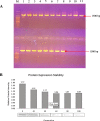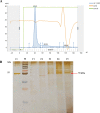Expression, purification, and characterization of self-assembly virus-like particles of capsid protein L1 HPV 52 in Pichia pastoris GS115
- PMID: 37981617
- PMCID: PMC10657913
- DOI: 10.1186/s43141-023-00571-0
Expression, purification, and characterization of self-assembly virus-like particles of capsid protein L1 HPV 52 in Pichia pastoris GS115
Abstract
Background: Cervical cancer caused by the human papillomavirus (HPV) is one of the most frequent malignances globally. HPV 52 is a high-risk cancer-causing genotype that has been identified as the most prevalent type in Indonesia. Virus-like particles (VLP)-based vaccinations against HPV infection could benefit from self-assembled VLP of L1 capsid protein.
Result: The recombinant HPV 52 L1 was expressed in Pichia pastoris on a shake-flask scale with 0.5% methanol induction in this study. The copy number was used to compare the expression level and stability. The colony that survived on a solid medium containing 2000 μg/ml of Zeocin was selected and cultured to express HPV 52 L1. DNA was extracted from the chosen colony, and the copy was determined using qPCR. HPV 52 L1 protein was then purified through fast performance liquid chromatography. Transmission electron microscopy (TEM) evaluation confirmed the VLP self-assembly. The genomic DNA remained intact after 100 generations of serial cultivation under no selective pressure medium conditions, and the protein produced was relatively stable. However, the band intensity was slightly lower than in the parental colony. In terms of copy number, a low copy transformant resulted in low expression but produced a highly stable recombinant clone. Eventually, the L1 protein expressed in Pichia pastoris can self-assemble into VLP. Therefore, recombinant HPV possesses a stable clone and the ability to self-assemble into VLP.
Conclusion: The recombinant L1 HPV 52 protein is successfully expressed in P. pastoris within a size range of approximately 55 kDa and demonstrated favorable stability. The L1 protein expressed in Pichia pastoris successful self-assembled of HPV VLPs, thereby establishing their potential efficacy as a prophylactic vaccine.
Keywords: Capsid protein L1; HPV 52; Protein purification; Recombinant Pichia pastoris; VLP-based vaccine.
© 2023. The Author(s).
Conflict of interest statement
The authors declare that they have no competing interests.
Figures





Similar articles
-
Production of codon-optimized Human papillomavirus type 52 L1 virus-like particles in Pichia pastoris BG10 expression system.Prep Biochem Biotechnol. 2023;53(2):148-156. doi: 10.1080/10826068.2022.2048262. Epub 2022 Mar 18. Prep Biochem Biotechnol. 2023. PMID: 35302435
-
VLP Production from Recombinant L1/L2 HPV-16 Protein Expressed in Pichia Pastoris.Protein Pept Lett. 2018;25(8):783-790. doi: 10.2174/0929866525666180809124633. Protein Pept Lett. 2018. PMID: 30091403
-
Broad Cross-Protection Is Induced in Preclinical Models by a Human Papillomavirus Vaccine Composed of L1/L2 Chimeric Virus-Like Particles.J Virol. 2016 Jun 24;90(14):6314-25. doi: 10.1128/JVI.00449-16. Print 2016 Jul 15. J Virol. 2016. PMID: 27147749 Free PMC article.
-
Developments in L2-based human papillomavirus (HPV) vaccines.Virus Res. 2017 Mar 2;231:166-175. doi: 10.1016/j.virusres.2016.11.020. Epub 2016 Nov 23. Virus Res. 2017. PMID: 27889616 Free PMC article. Review.
-
Virus-like Particle-Based L2 Vaccines against HPVs: Where Are We Today?Viruses. 2019 Dec 23;12(1):18. doi: 10.3390/v12010018. Viruses. 2019. PMID: 31877975 Free PMC article. Review.
Cited by
-
Development of human papillomavirus and its detection methods (Review).Exp Ther Med. 2024 Jul 31;28(4):382. doi: 10.3892/etm.2024.12671. eCollection 2024 Oct. Exp Ther Med. 2024. PMID: 39161614 Free PMC article. Review.
References
-
- ICO HPV Information Centre. 2017. Indonesia; Human papillomavirus and related cancers, fact sheet 2017. Available from: http://www.hpvcentre.net/statistics/reports/IDN_FS.pdf.
-
- Hoang Dang Phan N, Thanh Nguyen T, Thanh Vo N, Tuyet Thi Le T, Bao Hoang Tran T, Kim Truong P, Ai Huyen Le T, Duc Lao T. Epidemiology, incidence, mortality of cervical cancer in Southeast Asia and their relationship: an update report. Asian Journal of Pharmaceutical Research and Health Care. 2020;12(3):97–101. doi: 10.18311/ajprhc/2020/25208. - DOI
-
- Rachmani B, Shaluhiyah Z, Cahyo K. Sikap Remaja Perempuan Terhadap Pencegahan Kanker Serviks Melalui Vaksinasi HPV di kota Semarang. Media Kesehatan Masyarakat Indonesia. 2012;11(1):34–41. doi: 10.14710/mkmi.11.1.34-41. - DOI
Grants and funding
LinkOut - more resources
Full Text Sources
